Two broad categories: natural fiber and synthetic.
Natural fiber; Made from plants, easily made by hand, but affected by moisture and humidity, and rots easily. Best available is manila. Weakest is cotton.
Synthetics:
Have mostly replaced natural fibers, much stronger, doesn't rot from moisture.
Have mostly replaced natural fibers, much stronger, doesn't rot from moisture.
- Nylon: first and strongest of common petroleum plastics used for fiber. Very strong but very stretchy. Deteriorates under UV. Slippery, needs special attention w/ knots. Good hand.
- Polyester: a.k.a. Dacron. Nearly as strong as nylon, somewhat heavier. Very little stretch, not quite as slippery as nylon and holds knots better. Good hand. Best replacement for manila in most theatre situations.
- Polypropylene, polyolefin: lighter, cheaper, but weaker than nylon or Dacron. Tends to be stiffer and slipperier. Not as good a hand. Floats.
- Polyethylene: light, cheap, weaker and stiffer than other synthetics, but fairly immune to UV. Poor hand, floats. Common as hollow braided water skiing rope.
Construction of rope:
Twisted, most commonly used for traditional natural fibers that take a set.
- Fibers twisted into YARNS.
- Yarn twisted into STRANDS.
- Strands twisted into LAYS.
Typical pattern: 3-strand lay. Four stand also possible.
Braided, most common for softer fibers that don't take a set well, cotton and most synthetics. Multiple strands braided into BRAIDS.
- Three strand: Produces flat rope, easiest hand braid but otherwise not used.
- Four strand braid and up (e.g. 8-strand, 12 strand, etc.): Produces round rope, is much more typical, almost always machine made. Creates a cylinder of rope, a tube of fiber with a hollow core.
Three typical patterns:
Hollow braid: is left unfilled; very flexible rope. Very easy to splice or to pass a fid through without damage. Ex. water skiing rope.
Kernmantle ropes: Braided rope around a core material.
Single-braid: braided mantle around a core of parallel fibers. Core may just be filler, but often adds greatly to strength of rope, depending on material used.
Most common construction for synthetics. Subject to some "milking" depending on stretch of core vs. mantle.
Most common general-purpose synthetic rope.
Double braid: literally, a braided mantle around a braided core, a rope within a rope.
Often stiffer than single braid, harder hand, great tendency to "milk".
Material strength:
Based on Safe Working Load or SWL; ultimate break strength is at least 5x's SWL
| Fiber | Rope Diameters | |||
|---|---|---|---|---|
| 3/8" | 1/2" | 3/4" | 1" | |
| Natural Fiber | ||||
| Manila | 200 | 440 | 1080 | 1880 |
| Sisal | 150 | 350 | 865 | 1440 |
| Synthetics | ||||
| Nylon | 400 | 780 | 1800 | 3600 |
| Dacron | 390 | 745 | 1870 | 3220 |
| Polypro | 300 | 600 | 1600 | 2800 |
Knots
There are thousands of knots for all kinds of rope work. One stage, many ropes and knots are used. There are a handful of knots every stagehand should know which will cover the vast majority of needs.
The parts of a rope are: The Ends and the Standing Line (the long middle part of a rope not in the knot). A Bight is a bend in the rope that does not cross back across itself. A Loop is a bend in the rope that DOES cross itself. A Hitch is knot that ties a rope to something else, a Bend is a knot that joins two ropes. The Bitter End is the very end of the rope, especially if you are sliding down it!
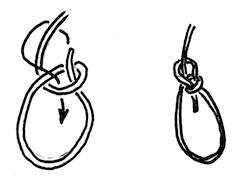
The Bowline is THE prime theatre knot. Tied properly it WILL NOT slip. If you remember only one knot, this is it. It is used to tie a fixed loop in the end of a rope. Riggers use it on a rigging line to send equipment into the air. Electricians use it to send instruments up to the beams on a rope. It can make a non-slip loop around an object, or if tied back around the rope like a lasso, will tighten down on the object. It can even be used to tie two ropes together by putting a bowline in the end of one line, the tying a bowline in the end of the other through the first bowline. This is the best method of adding rope to a spotline on a "rope" system that is a little short, because it is even more secure than a sheet bend in stiff, heavy ropes.

The Square Knot a binding knot used to tie a rope around something to secure it. It can also be used to tie two identical ropes together, but the MUST be of the same size, material, age, and condition, or the knot WILL slip. For joining two ropes, a sheet bend is superior.

The Sheet Bend is used for joining two ropes. It will work with identical ropes or ropes of different sizes, materials, and stiffness. It is less likely than a square knot to slip.
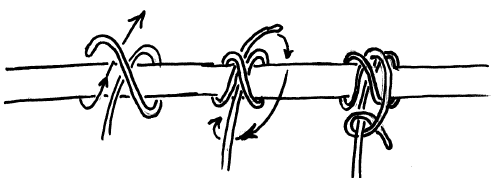
A Clove Hitch is used to tie a rope to a batten or post. It is usually finished with a half-hitch stopper back around the standing line to prevent slippage, as a safety. If you learn only two knots, the bowline is the first, and this is probably the second.
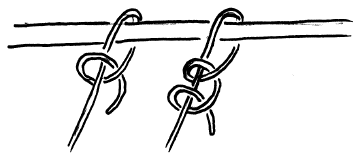
Two Half-hitches are also used to tie a rope to a batten or post, but by itself it not as strong as a clove hitch. However, if the rope is passed around the bar two or three times and then secured with two half hitches, it will be very strong. This method is especially useful for dead-hanging something directly from an overhead support.
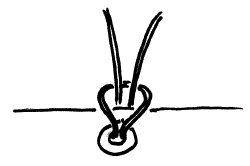
Tie-line Knot or Larks head is used to attach a tie-lines to the grommets of a curtain or drop so it can be tied to a batten.
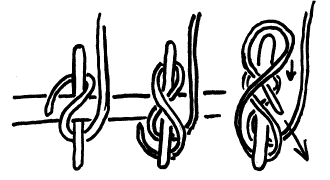 Pin-rail Tie-off or Belay knot is used to tie the ropes of a ropes system to the belay pins of a pin-rail.
Pin-rail Tie-off or Belay knot is used to tie the ropes of a ropes system to the belay pins of a pin-rail. 
Prussic knot is used to attach a wire rope loop to the batten ropes of a ropes system. Sandbags are then clipped to the loop as counterweight.
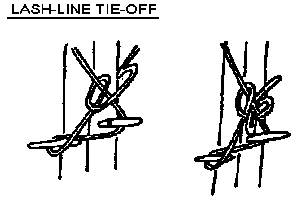
Lash Line Tie-offs are ways to finish a flat lashing which can be easy secured and untied. This is one of several methods used, and is simply two half-hitches with the second hitch tied with a loop to be slippery.
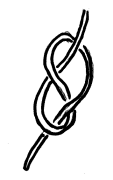 A Figure-8 knot is used to put a knot in a rope so it won't accidentally run back through a pulley or sheave. It can also be useful to keep the end of a rope from unraveling.
A Figure-8 knot is used to put a knot in a rope so it won't accidentally run back through a pulley or sheave. It can also be useful to keep the end of a rope from unraveling.
No comments:
Post a Comment